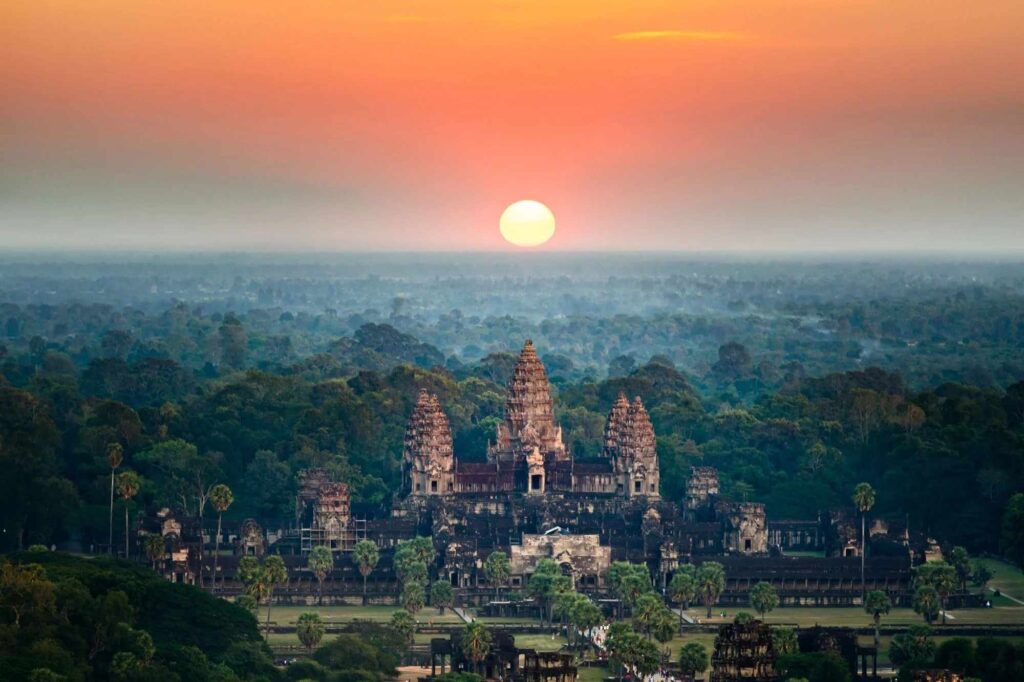Angkor Wat, Cambodia travel tips
Category
Categories
Popular Articles

Angkor Wat, Cambodia is one of the most exclusive archaeological sites in Southeast Asia. It’s famous worldwide due to its unique Khmer architecture, the sprawling temples, and stunning sunrises that have been captured throughout the centuries. Crowned as the world’s largest religious monument, this awe-inspiring temple complex is a UNESCO World Heritage Site that stretches over an astounding 400 km². The grandeur and harmony of the architecture combined with the rich heritage and culture lived and experienced here truly make this a must-visit destination when in Cambodia.
Best Time to Visit
The ideal time to visit Angkor Wat is between November and February when the weather is dry and relatively cool. It’s the peak season due to comfortable temperatures for walking and exploring the temples. The rainy season from June to October offers lower tourist crowds and a greener landscape, adding to the mystic atmosphere. The famous Angkor Wat International Half Marathon usually takes place in December and attracts many global tourists.
Climate & What to Pack
Cambodia experiences a tropical climate. From November to February, the weather can be quite cool so it’s recommended to pack lighter clothing for the daytime and a jacket for cooler evenings. For the hotter months (March to June), breathable fabrics are advisable, whereas the rainy season requires waterproof clothing and sturdy shoes. Regardless of the time of your visit, essentials include a hat, sunglasses, sunscreen, comfortable walking shoes, a reusable water bottle, and insect repellent.
Getting There
The nearest airport to Angkor Wat is the Siem Reap International Airport (REP). From the airport, it’s a 30-min drive to the temple complex. Visitors can hire a tuk-tuk, taxi, or private cars. Cambodia provides visa on arrival facilities for most countries, but do check the latest updates before your travel planning.
Getting Around Locally
Hiring a tuk-tuk is the most popular way to explore Angkor Wat and the nearby city of Siem Reap. Bicycles and e-bikes are also available and offer an eco-friendly way to travel the city. For a less physically strenuous option, consider hiring a car or a scooter.
Safety Tips
Cambodia is relatively safe for several tourists but do exercise usual travel precautions. Avoid venturing out alone late at night. Beware of common tourist scams such as overcharging, particularly in tourist-heavy areas. As a show of respect, dress appropriately when visiting religious sites. Solo female travelers should exercise some extra caution.
Top Things to Do & See
Besides the main Angkor Wat complex, other must-see attractions include Bayon Temple and the Ta Prohm Temple. Don’t miss the Angkor National Museum and the traditional floating villages on Tonle Sap Lake. For a unique experience, board a hot-air balloon for a bird’s eye view of the site, or watch a traditional Apsara dance performance.
Where to Stay
Accommodation options vary from budget hostels to luxurious resorts. High-end offerings include Raffles Grand Hotel d’Angkor and Angkor Palace Resort & Spa. Mid-range options are Tara Angkor Hotel and Siddharta Boutique Hotel. Budget travelers can find affordable rooms at Onederz Siem Reap and Lub d Cambodia Siem Reap.
Food & Local Cuisine
Khmer cuisine is fresh, flavorful, and often healthy. Must-try dishes include Fish Amok, Khmer curry, and Lok Lak. For the best local food options, check out the street food stalls at Phsar Chas market and the upmarket restaurants like Cuisine Wat Damnak and Malis.
Cultural & Practical Tips
Cambodia’s local currency is the Cambodian riel, but US dollars are widely accepted. The local language is Khmer, and while English is spoken in many tourist areas, learning a few local phrases will go a long way. Tipping is appreciated, but not mandatory. Also, Cambodia uses types A, C, and G plugs at 230V, so be sure to bring a universal adapter.
Sustainable or Responsible Travel Tips
Help preserve Angkor Wat’s beauty by not climbing on ancient structures, littering, or taking away any artifacts. Always ask for permission before photographing locals. Consider supporting locally-run businesses and artisans.
To conclude, exploring Angkor Wat is like stepping back in time, and each temple has its own unique story to tell. So take your time, look closely beyond just the main attraction, and let this marvel of the ancient world reveal its secrets to you!










